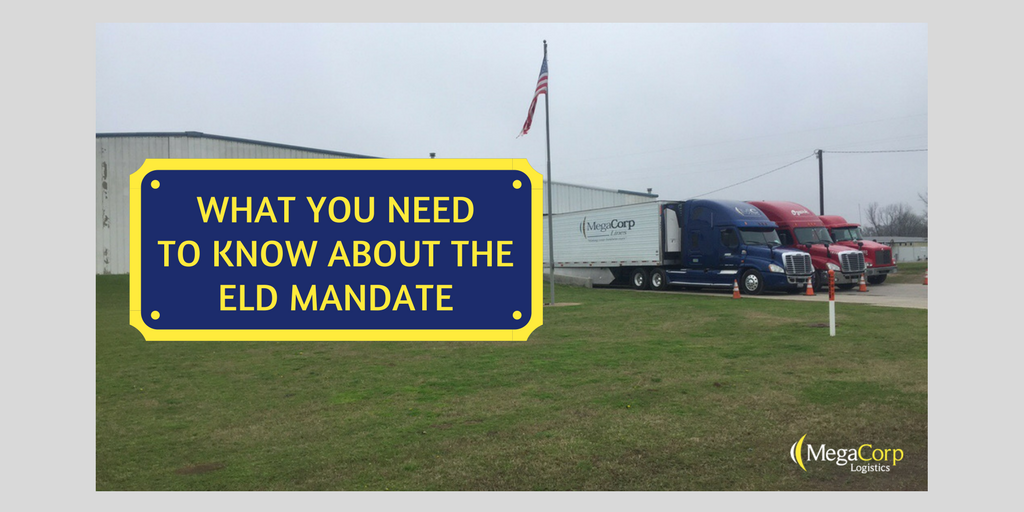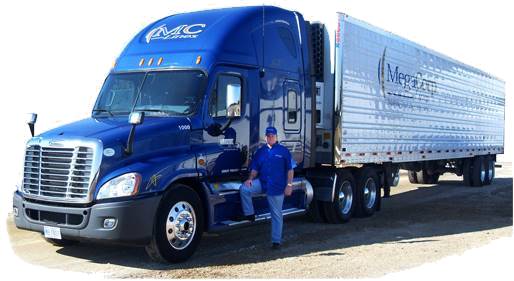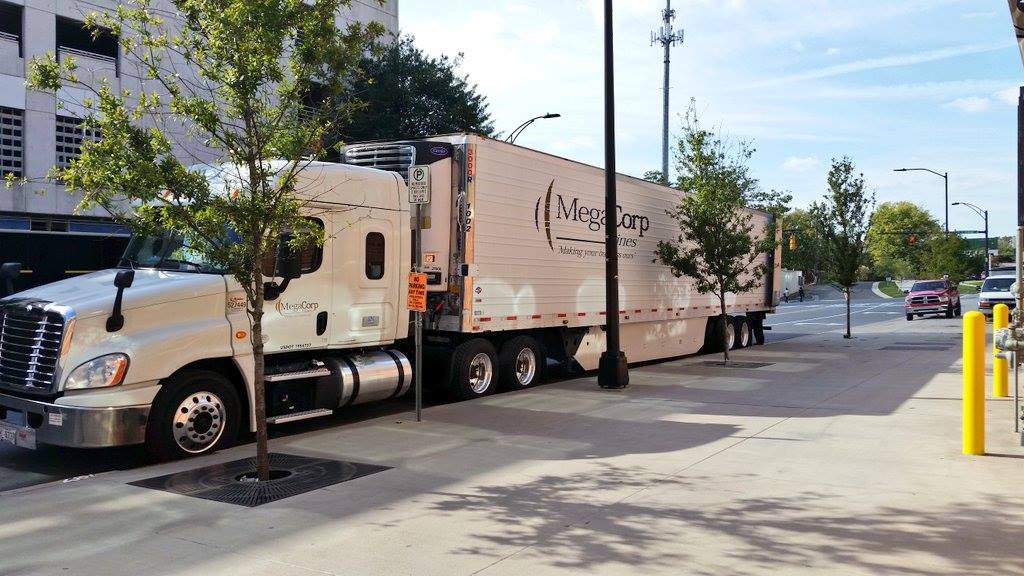[av_textblock size=” font_color=” color=” av-medium-font-size=” av-small-font-size=” av-mini-font-size=” av_uid=’av-40ovv4′ custom_class=” admin_preview_bg=”]

Electronic Logging Devices (ELDs)
What is an ELD and what is the timeline for implementation?
The Federal Motor Carrier Safety Administration (FMCSA), a branch of the US Department of Transportation, has mandated the installation of ELDs (Electronic Logging Devices) for drivers that are currently required to prepare Hours of Service (HOS) records. An ELD is a technology device that automatically records a driver’s driving time and facilitates the accurate recording of the driver’s HOS and that has been approved by the FMCSA.
ELDs are connected to the engine of the truck and show the data on a screen installed in the driver’s cab or on a smart phone app. The

device will automatically capture the engine on and engine off activities, including the date, time and location (within a 10 mile radius) of these activities. The ELD mandate will not change any of the current HOS rules.
This rule is intended to improve commercial motor vehicle safety and reduce the overall paperwork burden for both motor carriers and drivers. With the requirement of ELDs, compliance with the HOS rules will improve. The FMCSA estimates that 1,844 crashes will be avoided, 562 injuries avoided and 26 lives saved annually. The FMCSA also states that the implementation of ELDs will save over one billion dollars in time previously spent on paperwork.

All Commercial Motor Vehicles (CMV) must be using ELDs or Automatic On-Board Recording Devices (AOBRDs) by December 18, 2017. From December 18 to April 1, warnings will be given to anyone not compliant. After April 1, fines will be handed to anyone not compliant, with the potential to be put out of service. By December 12, 2019 any CMV that are using an AOBRD must convert over to the FMCSA approved and registered ELD device.

Are there any exceptions to the rule?
Yes, the following bullet points are the exceptions to the ELD mandate:
- ELDs are not required on CMVs older than model year 2000.
- Drivers that haul within a 100/150 air mile radius of their home base do not have to use ELDs.
- The rule also exempts drivers who use paper logs for no more than eight days during any 30-day period.
- The driveaway-towaway exception addresses unique aspects of those operations, but only if the vehicle driven is part of the shipment.
How will this affect the trucking and logistics industry?
ELD: Positive Impacts
Bill Graves, president of American Trucking Association states, “This regulation will change the trucking industry, for the better, forever. Since 1938, complex, on-duty/off-duty logs for truck drivers were made with pencil and paper, virtually impossible to verify,” Transportation Secretary Anthony Foxx said, “This automated technology not only brings logging records into the modern age, it also allows roadside safety inspectors to unmask violations of federal law that put lives at risk.”
Skip Kinford, CEO of the Americas at MiX Telematics, said the ELD rule will lead to safer roads and a “level playing field on compliance so there’s no competitive advantage” among carriers. -TRANSPORT TOPICS
This change also ensures drivers safety because drivers will have to rest once they reach their HOS which will promote more efficient and safe driving.
Individual supporters state that the mandate will make keeping logs more efficient, orderly, clear and accurate. Due to paperwork reduction, ELDs will make both the drivers and motor carriers more accountable for compliance. Commentators also noted that, “ELDs will speed up roadside inspections and simplify enforcement. This will make deliveries and pickups more efficient, thus saving time and money.” -FMCSA Federal Register. They also said, “The final ELD rule will result in an annual net benefit of more than one billion for the industry, largely by reducing the amount of required paperwork.”
“This will result in more precise logging and fewer opportunities to falsify logs. Trucking operators and their customers will be pressed to improve route planning and reduce detention time at shipper
customers and consignees.” -JOURNAL OF COMMERCE
ELD: Negative Impacts
Longer hauls will be less desirable for a single driver due to extended time the truck is covering a load. Many traditional next-day delivery lanes will be impacted due to less operating hours available for drivers to squeeze out extra miles. It is a possibility that drivers may not be able to make next day delivery commitments. Team drivers will become more in demand, which will, in turn, cost the customer more money, in order to pay for two drivers.

Two additional negative effects are parking and detention. Truck parking will become scarce as hours are depleted. Carriers will be unable to alter their logs so they will be forced to shut down early to find parking before they run out of hours. Delays on the dock will cause detention which will jeopardize the carrier’s next appointment. This costs the carrier even more when driver’s hours cannot be extended.
The motor carriers will not be able to make up their time, due to parking issues, detention and hours of service. This will increase costs, so they have no choice, but to raise their rates. It’s going to be the only way for them to make money on a given day.
The mandate means, “Tighter delivery schedules for shippers and less inherent flexibility in supply chains.” -JOURNAL OF COMMERCE
Analyst and fleet executives are projecting a significant reduction in freight hauling capacity anywhere between 3% and 5% as a result of the regulation. A survey of over 2,000 owner operators by Overdrive.com revealed that 14% are going to quit or retire when the enforcement date arrives. This equates to 98,000 trucks off the road. Fewer trucks on the road mean trucks will be in high demand, creating inflated prices.
If a truck cannot get loaded in time, they may run out of hours and have to wait 10 hours for a fresh drive clock before they can move again, causing service interruption.
ELD: How Can Shippers/Receivers Help?
✓ If possible, have a space reserved for trucks to park when they run out of hours. Truck parking has already become an issue and will only continue to get worse.
✓ Know the closest safe place for trucks to park (Walmart, Sam’s Club, rest area, etc).
✓ Expand shipping and receiving times.
✓ Load and unload as efficiently as possible.
✓ Review and update your detention and/or layover policies
ELD: Additional Information
The cost to install an FMCSA ELD ranges from about $400 to $2100. For example, a Qualcomm is $2,100 and an Omnitrac is $700. An ELD device will also have a yearly maintenance cost of about $400.
The FMCSA has not yet determined how much the fines will be but did indicate that one of the penalties for non-compliant trucks will be, the truck being put out of service.
Due to inclement weather, traffic/fatality accidents or other traffic incidences that prevent a driver from moving or getting to a safe stopping point to take a break, they can call their dispatch to request a “Safe Haven.” At this time, dispatch will look into how far away the driver is from the safe haven point (truck stop, etc.) and approve or deny the request. However, this still will affect the hours of on-duty service.
The actual Hours of Service rule have not changed. The following are still the Hours of Service:
11 – Maximum drive hours in a day
14 – Maximum on-duty hours in a day
10 – Consecutive hours off duty before driving can start again
70 – Maximum hours on duty in an eight-day period
34 – Number of hours off duty required to reset the 70 hour clock
70 hour/8 day clock, may drive only if 8 hours or less since last off-duty period of at least 30 minutes. The other option is to run a 60 hour/7 day clock if they prefer to keep logs on a week loop as opposed to the 8 days.
[/av_textblock]
[av_textblock size=” font_color=” color=” av-medium-font-size=” av-small-font-size=” av-mini-font-size=” admin_preview_bg=” av_uid=’av-2qpsj4′]
[/av_textblock]
